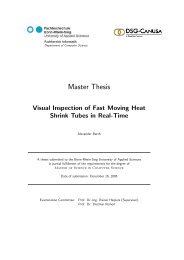Master Thesis - Hochschule Bonn-Rhein-Sieg
Master Thesis - Hochschule Bonn-Rhein-Sieg
Master Thesis - Hochschule Bonn-Rhein-Sieg
Create successful ePaper yourself
Turn your PDF publications into a flip-book with our unique Google optimized e-Paper software.
4. Overall evading concept <strong>Master</strong> <strong>Thesis</strong> Björn Ostermann page 54 of 126<br />
from<br />
part 2<br />
17<br />
Collision<br />
reset<br />
Reset collision status<br />
Transmit<br />
collision status<br />
to the Data<br />
Exchange<br />
Object<br />
Collision<br />
detected<br />
Set robot’s speed to<br />
zero<br />
Figure 33: Flowchart path planning control thread – part 3<br />
Handling collisions and transmitting the desired parameters<br />
Transmit the<br />
goal pose to the<br />
Data Exchange<br />
Object<br />
Transmit the<br />
robot’s speed to<br />
the Data<br />
Exchange<br />
Object<br />
Transmit the<br />
movement<br />
mode to the<br />
Data Exchange<br />
Object<br />
Next Loop<br />
If a collision is still reported, the robot’s speed has to be reduced to zero, which is handled in the next<br />
step. Since, due to technical reasons, this may not stop the robot at all times, a speed of zero is handled<br />
specially by the robot control thread (see chapter 4.5).<br />
In the end of every path planning control thread loop, the goal pose, the desired speed and the<br />
movement mode are transmitted via the data exchange object to the robot control thread.<br />
4.5 Robot control<br />
To be able to control the robot effectively, the exact pose of its tool centre point needs to be known.<br />
This pose has to be acquired from the robot’s internal sensors and made known to the developed<br />
program. On the other side, the pose data, computed in the path planning thread, have to be<br />
transmitted to the robot’s PLC.<br />
This data exchange between the PC-program and the robot is handled by the robot control task. Its<br />
task, as shown in chapter 4.1 is to pull all necessary sensor information from the robot, containing the<br />
current pose of all of the robot’s axes, and relay them to the path planning thread, as well as to relay<br />
the movement commands from the path planning thread to the robot.<br />
As a subtask, this thread also handles the manual movement commands, entered by the user in the<br />
GUI.














